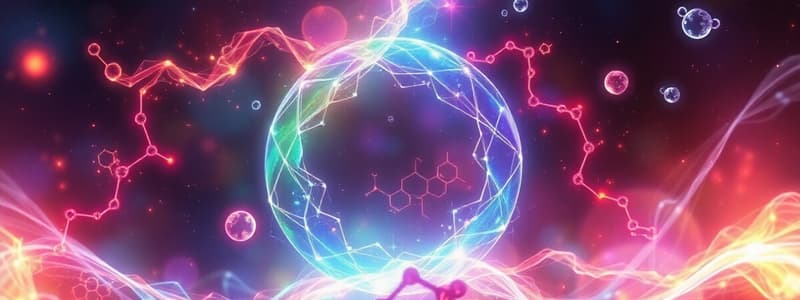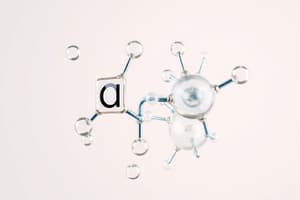Podcast
Questions and Answers
What is the primary characteristic of a solid?
What is the primary characteristic of a solid?
- Indefinite shape and volume
- Takes the shape of the container
- Particles are far apart
- Definite shape and volume (correct)
Which type of bond involves the transfer of electrons?
Which type of bond involves the transfer of electrons?
- Metallic bond
- Covalent bond
- Ionic bond (correct)
- Hydrogen bond
What type of reaction is represented by the equation $AB \rightarrow A + B$?
What type of reaction is represented by the equation $AB \rightarrow A + B$?
- Synthesis
- Combustion
- Decomposition (correct)
- Single Replacement
What characteristic is typical of acids?
What characteristic is typical of acids?
What does the Law of Conservation of Mass state?
What does the Law of Conservation of Mass state?
In the periodic table, which of the following is organized in vertical columns?
In the periodic table, which of the following is organized in vertical columns?
Which of the following best describes stoichiometry?
Which of the following best describes stoichiometry?
Which functional group is characteristic of organic acids?
Which functional group is characteristic of organic acids?
Flashcards are hidden until you start studying
Study Notes
Introduction to Chemistry
- Chemistry is the branch of science that studies matter, its properties, composition, structure, reactions, and changes.
- It is often referred to as the "central science" because it connects physics with other natural sciences.
States of Matter
-
Solid
- Definite shape and volume.
- Particles are closely packed in a fixed arrangement.
-
Liquid
- Definite volume but takes the shape of the container.
- Particles are close but can move past each other.
-
Gas
- Neither definite shape nor volume; expands to fill the container.
- Particles are far apart and move freely.
Chemical Bonding
-
Ionic Bonds
- Formed between metals and nonmetals.
- Involves transfer of electrons.
-
Covalent Bonds
- Formed between nonmetals.
- Involves sharing of electrons.
-
Metallic Bonds
- Occur between metal atoms.
- Involves delocalized electrons among a lattice of positive ions.
Chemical Reactions
-
Types of Reactions
- Synthesis: A + B → AB
- Decomposition: AB → A + B
- Single Replacement: A + BC → AC + B
- Double Replacement: AB + CD → AD + CB
- Combustion: Hydrocarbon + O₂ → CO₂ + H₂O
-
Law of Conservation of Mass
- Mass is neither created nor destroyed in a chemical reaction.
Acids and Bases
-
Acids
- Substances that donate protons (H⁺ ions).
- Sour taste, turn litmus red.
-
Bases
- Substances that accept protons or donate hydroxide ions (OH⁻).
- Bitter taste, slippery feel, turn litmus blue.
The Periodic Table
- Organized by atomic number, electron configuration, and recurring chemical properties.
- Groups: Vertical columns, elements with similar properties (e.g., alkali metals, noble gases).
- Periods: Horizontal rows, properties change progressively.
Stoichiometry
- The calculation of reactants and products in chemical reactions.
- Based on balanced equations to determine the mole ratios of substances.
Organic Chemistry
- Study of carbon-containing compounds.
- Key functional groups include:
- Hydroxyl (-OH): Alcohols
- Carboxyl (-COOH): Organic acids
- Amino (-NH₂): Amines and amino acids
Biochemistry
- The study of chemical processes within and related to living organisms.
- Major biomolecules include:
- Proteins: Chains of amino acids, crucial for structure and function.
- Carbohydrates: Sugars and starches, primary energy source.
- Lipids: Fats and oils, involved in cellular structure and signaling.
- Nucleic Acids: DNA and RNA, responsible for genetic information.
Key Figures in Chemistry
- Democritus: Proposed the idea of atoms.
- John Dalton: Developed atomic theory.
- Dmitri Mendeleev: Created the periodic table.
- Marie Curie: Known for her research on radioactivity.
Safety in Chemistry
- Always wear protective gear (gloves, goggles).
- Be aware of the properties and hazards of chemicals used.
- Follow proper disposal protocols for hazardous materials.
Introduction to Chemistry
- Chemistry studies matter and its properties, including its composition, structure, reactions, and changes.
- It's considered the "central science" because it connects physics with other natural sciences.
States of Matter
- Solid: Definite shape and volume; particles are closely packed in a fixed arrangement.
- Liquid: Definite volume but takes the shape of its container; particles are close but can move past each other.
- Gas: No definite shape or volume, expands to fill its container; particles are far apart and move freely.
Chemical Bonding
- Ionic Bonds:
- Formed between metals and nonmetals.
- Involves the transfer of electrons.
- Covalent Bonds:
- Formed between nonmetals.
- Involves the sharing of electrons.
- Metallic Bonds:
- Occur between metal atoms.
- Involves delocalized electrons among a lattice of positive ions.
Chemical Reactions
- Types of Reactions:
- Synthesis: A + B → AB
- Decomposition: AB → A + B
- Single Replacement: A + BC → AC + B
- Double Replacement: AB + CD → AD + CB
- Combustion: Hydrocarbon + O₂ → CO₂ + H₂O
- Law of Conservation of Mass: Mass remains constant during chemical reactions, meaning it's neither created nor destroyed.
Acids and Bases
- Acids:
- Donate protons (H⁺ ions).
- Sour taste, turn litmus red.
- Bases:
- Accept protons or donate hydroxide ions (OH⁻).
- Bitter taste, slippery feel, turn litmus blue.
The Periodic Table
- Organized by atomic number, electron configuration, and recurring chemical properties.
- Groups: Vertical columns; elements with similar properties (e.g., alkali metals, noble gases).
- Periods: Horizontal rows; properties change progressively as you move across.
Stoichiometry
- Calculation of reactants and products in chemical reactions.
- Based on balanced equations to determine the mole ratios of substances.
Organic Chemistry
- Study of carbon-containing compounds.
- Key functional groups include:
- Hydroxyl (-OH): Alcohols
- Carboxyl (-COOH): Organic acids
- Amino (-NH₂): Amines and amino acids
Biochemistry
- Study of chemical processes within and related to living organisms.
- Major biomolecules include:
- Proteins: Chains of amino acids, crucial for structure and function.
- Carbohydrates: Sugars and starches, primary energy source.
- Lipids: Fats and oils, involved in cellular structure and signaling.
- Nucleic Acids: DNA and RNA, responsible for genetic information.
Key Figures in Chemistry
- Democritus: Proposed the idea of atoms.
- John Dalton: Developed atomic theory.
- Dmitri Mendeleev: Created the periodic table.
- Marie Curie: Known for her research on radioactivity.
Safety in Chemistry
- Wear protective gear (gloves, goggles).
- Understand the properties and hazards of chemicals used.
- Follow proper disposal protocols for hazardous materials.
Studying That Suits You
Use AI to generate personalized quizzes and flashcards to suit your learning preferences.




